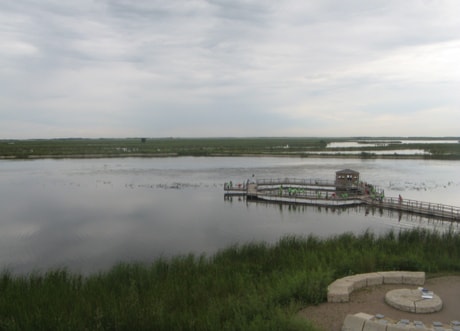STONEWALL, Man. — Just north of Winnipeg, in the middle of one of North America’s busiest bird migration routes, lies a pristine wetland that offers city dwellers a getaway to unspoiled views of birds, stars and the northern lights.
Oak Hammock Marsh, established by Ducks Unlimited and the Manitoba government, is made up of 36 square kilometres of land that was once drained for farmland. Now restored to its wet former self, the area is home to more than 300 species of birds — everything from finches to eagles to elegant white pelicans — as well as 30-odd types of mammals such as beavers and ground squirrels.
A quick, 20-minute drive from city limits, the marsh has a three-storey interpretive centre with a grass roof. It’s the highest structure within kilometres, so a visit to the rooftop observation deck provides a 360-degree view to the horizon. During the busy fall migration season, which lasts from early September to mid-October, you can watch hundreds of thousands of birds come and go from every direction.
“It’s a great staging area for migrating birds, almost like a little gas station along the highway would be for a car,” said Jacques Bourgeois, the facility’s event co-ordinator.
The marsh lies along a route used by birds that travel to northern Canada in the summer and as far south as Florida in the winter. The large wetland offers them a quiet, safe place to stop with plenty of food in the green, swampy water. The birds will gorge for two or three weeks, eating what would amount to dozens of pizzas each day for a human. They add 10 per cent to their body weight before continuing on their long journey.
Everything about Oak Hammock Marsh is, literally, for the birds. The interpretive centre’s low-profile and grass-top roof make it look like a hill when viewed from above. Some birds even nest in the green rooftop. The 30 kilometres of unpaved walking trails that meander through the marsh are designed to minimize human impact on the environment.
Even the cafe-style restaurant is designed with birds in mind. All tables lie alongside a wall with immense windows, and each table has a pair of binoculars tied to it. During the fall migration, the cafe goes upscale, offering four-course gourmet dinners timed to coincide with the nightly return of birds from the outer reaches of the marsh to their nesting places.
“It’s a huge cloud of birds,” Bourgeois said.
During the day, guides offer walking tours, educational films and some hands-on exhibits inside a small museum that would please kids. Canoe rides are available, as are snowshoe treks in winter. On a recent walking tour with my children, the gentle, silent glide of a pelican overhead was interrupted by a sudden eruption of tiny shrieks from a group of killdeers running excitedly across the path in front of us.
“There must be a nest nearby,” said our guide Tabitha. After five years working at the marsh, Tabitha is well-versed in the seemingly endless species of birds, bugs and animals that scurry around us. She rattles off the names of five kinds of insects that skim along the surface of the still water, engrossing (and slightly grossing out, in a good way) my sons.
While the centre is clearly bird-focused, it has expanded its programming to appeal to other, more celestial forms of nature. Because it is just far enough away from Winnipeg to be free of light pollution, the centre provides a clear view of the stars on a cloudless night. Once a month, the centre offers an indoor theatre presentation about the constellations followed by a look at the real thing from the rooftop. The star-gazing tour can also be booked privately at other times.
The area has also become a hot spot for people to see the northern lights in fall, when the days get noticeably shorter and aurora borealis visibility seems to peak. And this fall is shaping up to be a good one, Bourgeois said.
“Right now, the sun is just coming out of a low cycle of activity. For the past few years, it was very rare to see northern lights,” he said. “But on a good year, when the sun is very active, you’ll see northern lights just about every second or third day.”
If you go
• Oak Hammock Marsh is off highway 67. From Winnipeg, take McPhillips Street north, which becomes highway 8, and follow the blue signs.
• Admission is $6 for adults, $5 for seniors and $4 for children.
• The Oak Hammock Marsh website is http://www.oakhammockmarsh.ca
